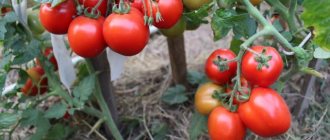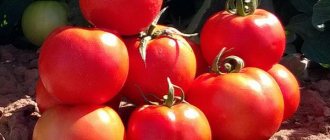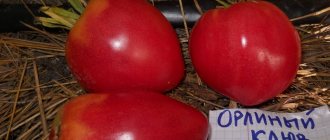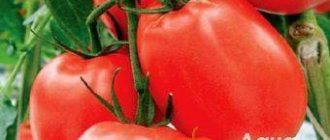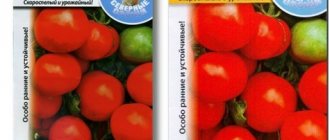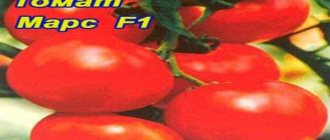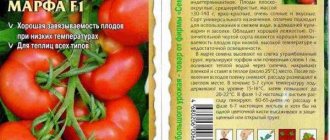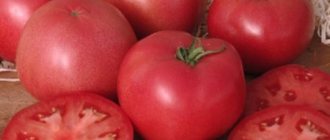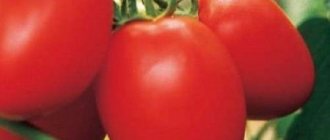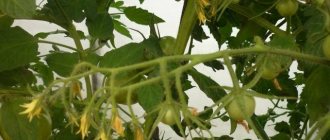The Female Share tomato is a favorite and desired hybrid, like all beautiful representatives of humanity. It has an exquisite taste and productivity. Not at all capricious, but on the contrary, stable and hardy, like “women in Russian villages.”
| Height | Landing location | Ripening time | Fruit color | Fruit size | Origin | Fruit shape |
| Tall | Greenhouse, Open ground | Early ripening | Reds | Large | Hybrid | Flat-round |
Description of tomatoes Female share F1
A powerful plant of an early-ripening indeterminate tomato, the female share can rise above 2 m, but the growth of the stems must be limited. At approximately a height of 1.6-1.8 m, the top of the central trunk is pinched. The stem of the variety is strong and needs shaping, pinching and staking in order to withstand the mass of large-fruited tomatoes. The bush is well leafy. When properly grown, the root system is spreading and located shallow from the surface. On the fruit clusters of self-pollinating tomatoes, the female share produces up to 10 buds. To obtain large fruits, only 3 ovaries are left on the cluster.
Important! Early ripening tomatoes Female share F1 are bred on the basis of a cold-resistant and early variety.
A feature of the hybrid tomato is the reduction in the weight of the fruits on the upper clusters. Therefore, tomatoes from the lower cluster are often picked at half ripeness, turning brown, to enable the plant to form large fruits on the last fruiting branches. Unripe tomatoes are ripened indoors without direct sunlight. Fruit clusters are laid after 5-6 leaves. An average of 7-9 ovaries are formed on each. The next fruit branches are created through 4 leaves. The ribbed fruits of the Female Lobe F1 tomatoes have an original shape, which emphasizes its salad direction. The tomato seems to consist of several, up to 2 dozen, slices, flattened on top. The size of tomatoes ranges from 6-8 cm in diameter. In horizontal as well as lateral longitudinal sections, an oval-elongated boat shape can be seen. The fruits from the 2 lower clusters weigh from 180 to 250 g, the upper ones are slightly smaller - from 130 to 170 g. The tomato skin is thin, durable, and does not crack. The color of the skin and pulp is red, at the junction with the stalk there is a noticeable greenish pigment spot.
The pulp of the hybrid Female lobe F1 is juicy, fleshy, there are no voids. Small seed chambers are found in almost every lobule. The seeds are small and cannot be collected for self-propagation. Tomatoes marked F1 are hybrids; the seeds are produced in a specialized agricultural company.
An unusual aromatic variety masquerading as peppers - the Auria tomato: the secrets of a high yield
Those who like to experiment with growing unusual varieties of vegetable crops will not ignore the Auria tomato variety. It is famous for its very high yield and taste of its fruits.
| Height | Landing location | Ripening time | Fruit color | Fruit size | Origin | Fruit shape |
| Tall | Greenhouse, Open ground | Mid-season | Reds | Average | Hybrid | Pepper-shaped |
Description and characteristics of the variety
The hybrid is indeterminate, non-standard. It reaches a height of 1.5-2 meters. The bush is a liana-like plant, medium-leaved, with a flexible trunk. In terms of ripening, it is classified as mid-season. Large stems are densely covered with carved leaves of light green color.
Due to the irregular shape of the fruit, the Auria tomato is also called Fun, Lady's Caprice, Manhood, Eros or Adam. Tomatoes have an oblong shape with a forked end. Unripe fruits are green-yellow, becoming bright red when ripe. The cut has a uniform red color, no white veins. Auria tomatoes are 12-14 cm long and weigh 150-180 g.
The flesh is fleshy and dense. They have an attractive aroma and rich taste. There are very few seeds in the chambers.
Country of origin
Tomato Auria is a very young hybrid. It was bred in 1997 by Novosibirsk breeders, but to this day it is gaining popularity among gardeners.
Which regions are best to grow in?
In the middle zone and Siberia, the plant requires greenhouse conditions for cultivation. The climate of the southern regions allows for growing tomatoes in open ground.
Advantages and disadvantages
Pros:
- resistant to fruit cracking;
- very high yield;
- excellent taste and aroma;
- unusual shape of the fetus;
- tolerance to temperature changes;
- resistance to diseases;
- suitability for storage and transportation.
Minuses:
- needs pinning and fixation with supports;
- demanding of potassium and calcium;
- falls off the bush when ripe.
Productivity
The richness of the harvest depends on the following factors:
- soil;
- seed preparation;
- places of growth;
- care;
- regularity of fertilizing and watering.
If all requirements for growing the variety are met, up to 14 clusters are formed on one bush, each of which produces from 6 to 8 tomatoes. Thus, about 6-7 kg of tomatoes can be harvested from one plant.
Features of cultivation and storage
Many farmers use a commercial soil mixture to sow seeds, but it can also be prepared at home. The composition includes ordinary humus and soil (in a 1:1 ratio) with the addition of peat. During growth, you need to fertilize the soil with potassium 3 times.
Suitable soil for growing tomatoes is considered to be the same soil on which carrots, cauliflower, parsley, dill or cucumbers were previously grown. These plants provide the soil with suitable organic matter, which contributes to a good tomato harvest. Due to the fact that the fruits of Auria tomatoes do not overripe, they can be stored for a long time.
Planting and care
Before sowing seeds for seedlings, they must be soaked in a weak solution of potassium permanganate for disinfection for half an hour. Then rinse thoroughly and leave in water until they swell. Seeds are sown in small seedling pots and covered with film to create a greenhouse effect.
The suitable temperature for seedlings is 24 °C. It is necessary to water only after the soil has completely dried. After the first shoots appear, the seedlings should be placed in a room with a temperature of 18°C.
Sowing seeds for seedlings is carried out 55-60 days before planting in the ground. Fertilizing with organic substances begins when the first two leaves of the plant appear.
When 3 leaves are formed, they are picked - transplanted into boxes or another larger container.
Tomatoes require staking and pinching. But it is not demanding on moisture; one watering per week is enough. A bush is usually formed into 1-2 stems, depending on climatic conditions, to obtain a rich harvest.
To grow Auria tomatoes in greenhouse conditions, before planting the bushes, it is advisable to disinfect the greenhouse, ventilate and moisten the soil.
Due to the fact that the bush itself is tall and vine-like, it needs to be tied up. This will prevent strong winds from breaking the stem.
Early maturing / TallUser rating: 4/5Ultra early / TallUser rating: 4/5Mid maturing / TallUser rating: 5/5
Pros and cons of the tomato variety Female share F1
Tests of the hybrid show that tomatoes are in demand, since the variety has many advantages:
- good and stable yield;
- early ripeness;
- long fruiting;
- cold resistance, as well as endurance to temperature changes;
- low susceptibility to viral and fungal diseases.
The hybrid has its own disadvantages:
- mandatory formation for declared yield;
- reproduction only through specialized farms.
Characteristics of the variety
The variety is tall, early ripe. The plant produces a large number of clusters on which fruits of interesting shapes grow. The plant can be grown in garden beds and greenhouses. The ripening period is approximately 90 days. The variety is distinguished by the fact that it produces a lot of yield. In addition, the fruits are very large - the weight of one tomato is 200 g. The bush reaches a height of 180 centimeters, three or four clusters with fruit ovaries are left on it. Other brushes do not have time to mature.
A ripe tomato has a bright red color. The fruit is divided into lobes, the surface is ribbed, the shape is flattened - the appearance of the tomato resembles a pumpkin.
The pulp is juicy and meaty. The taste is not pronounced, with a slight sourness. The variety is used for various culinary purposes - the fruits are canned, salads, sauces and many other dishes are prepared from them.
Growing tomatoes Women's share
Hybrid seeds, already treated for fungi, are sold by distributors from Uralskaya Usadba. Seedlings are sown in March or April, depending on where the seedlings will be placed - in a greenhouse or in a garden. 10 days after diving, the sprouts are fed with a complex preparation for tomatoes. Seedlings destined for the garden are hardened off for 12-14 days before moving.
Landing rules
Tomatoes are transplanted into a film greenhouse in early May, and into the garden after stable warming, from late May to mid-June. During this time, the seedlings have been growing for almost 2 months and have formed 6-8 leaves and the first flower cluster. 10 days before transplantation, you can spray with Bordeaux mixture to avoid late blight infection. Landing algorithm:
- the holes are placed according to a 50x50 cm pattern;
- the holes are watered abundantly;
- 1 tablespoon of ammonium nitrate is placed in each growth hole;
- seedlings with a clod of earth are placed in a hole and the soil is compacted;
- later mulch is spread around the stems.
Attention! Before transplanting, tomato seedlings are sprayed with a weak solution of boric acid (1 g per bucket of water) so that the buds can withstand stress.
Watering and fertilizing
In the greenhouse, tomatoes are watered 2 times every 7 days, ventilated, making sure that the humidity does not rise above 65%. Fertilizing is carried out 2 times a month with mineral complexes or, less often, with organic solutions.
Pinching and tying
On plants, shoots appear in the axils of the leaves, which are pinched and removed once a week. For a hybrid, it is recommended to leave a strong lower stepson in order to form a second trunk on its basis. When removing shoots, 2 weeks after transplantation, the stems are tied to a trellis.
Formation
To get a good harvest of F1 category tomatoes, it is recommended to plant the plant in 2 stems. 3 ovaries are left on each cluster, and then the tomatoes will reach over 200 g. The lower leaves are removed.
Protection from diseases and pests
The female lobe hybrid is resistant to various pathogens of fungal diseases. For prevention they practice:
- moderate watering;
- timely feeding;
- loosening after watering and complete removal of weeds;
- low humidity, which is regulated by ventilation.
The same measures prevent the appearance of whiteflies. Aphids are sprayed with soda or soap solution, while removing ant nests.
Features of cultivation and storage
For seedlings, seeds are sown in light soil in March and moderately watered with warm water from a spray bottle. You need to pick up the sprouts when the first leaf appears, after which you should feed them with a solution of mineral fertilizers.
Young plants are transplanted into closed ground at the beginning of May so that the ovaries appear at the end of June. Depending on their growth, mid-ripening tomatoes require staking and removal of side shoots, while bushes of early-ripening varieties form their crown independently.
The soil under young plants is regularly loosened. To ensure a sufficient level of moisture, mulching helps: covering the ground under young plants with sawdust or straw to prevent it from drying out.
According to the time of ripening, cluster tomatoes are divided into early and mid-late. Tomato bushes vary in height, take different shapes and require different agricultural operations. Look at the article: The most popular varieties of tomatoes: a brief description of the varieties.
Medium ripening greenhouse tomatoes are mostly tall and often produce large tomatoes. In addition to weeding and loosening the soil, they need to remove side shoots and leaves below the ovary. After the eighth ovary appears on the bush, the top is removed to form larger fruits.
Tomato Zhenaros F1
Excellent reviews of the Zhenaros F1 tomato indicate that this tomato has especially large fruits. The shape of the fruit is round, the pulp is tasty, the peel is dense, so it does not crack. The mid-season variety is characterized by high resistance to viral and putrefactive diseases.
Tomato Zhenaros F1
The bush is unpretentious and bears fruit for a long time. The only thing it does not tolerate well is prolonged drought. Can grow on soils poor in useful minerals. The fruits are bright red in shape, reminiscent of strawberries and have a pleasant taste.
A detailed description of the tomato Mushroom Basket informs about varieties with ribbed fruits. Not only is it original, but it is also famous for the mild taste of the fruit. Tall tomato vines (indeterminate variety) are attached vertically to trellises and side shoots are removed, which makes it possible to achieve an enlarged mass of fruit.
The greenhouse variety is distinguished by excellent fertility, although it is very thermophilic and in cool weather reduces the number of ovaries. Pests are controlled by frequent ventilation of the greenhouse and preventive spraying with a weak solution of potassium permanganate.
Positive reviews about the King of Kings tomato with a late fruiting period of this tall plant that is grown in two stems. It is tied to a vertical support; the pink fruit has a special taste.
Tomato Slasten
The original Slastena tomato for indoor soil, is heat-loving and requires a lot of sunlight and sufficient air humidity. Then the round, bright red fruits will delight you with their excellent taste.
Young plants are planted in the greenhouse at the beginning of May so that the fruits set in June, and immediately provide them with good support. Bright red oval fruits are distinguished by juicy pulp and thick skin. These properties ensure long-term storage of tomatoes and excellent transportation capabilities.
Tomato Zhigalo
Impressive reviews of the Zhigalo tomato focus more on its sausage-like shape; these tomatoes are easy to stuff by removing a small amount of the pulp inside the tomato.
The mid-season tomato Zhigalo Biotekhnika is designed specifically for indoor soil and is famous for its long and abundant fruiting.
Carpal tomatoes produce standard-sized fruits. They are densely and evenly located on a long brush. Tomatoes ripen almost simultaneously, are not prone to cracking and do not fall off. Early tomatoes are left to grow in two clusters and no longer form a bush. They do not need a garter, they are only raised above the ground.
Carpal tomatoes in greenhouses need abundant watering with warm water, regular ventilation and loosening of the soil. To protect against diseases, plants are sprayed with antifungal and antiviral drugs.
Seeds are planted in loose leaf turf, which is mixed with compost, peat, and sand.
Planting depth is 1.5 cm, distance between grooves is 4 cm.
To grow strong seedlings, a number of nuances are observed:
- irrigation through a spray bottle;
- diving and hardening;
- 2-time feeding - 10 days before and after picking.
Medium early/Tall
User rating: 4/5
Mid-season / Tall
User rating: 4/5
Medium early/Tall
Advantages and disadvantages of the variety
The main advantage of the Aphrodite tomato is its high frost resistance and good taste. This makes it possible to successfully grow tomatoes in many farms and private farms in the Urals and Siberia.
Aphrodite tomatoes are able to maintain their presentation for a long time
pros
- pleasant sweetish taste;
- juiciness;
- universal use (fresh and for preparations);
- round shape, presentation;
- resistance to diseases and pests;
- the fruits ripen in 3 months and appear almost simultaneously;
- ability to withstand long-term transportation.
Minuses
- it is necessary to form bushes;
- you also need to tie up the plants - otherwise the fruits will not be so large.
Characteristics of tomato
This is an early-ripening, tall bush with many brushes on which tomatoes of unusual shape ripen. The tomato is suitable for growing in greenhouses and open ground. It takes about 3 months from sowing the seeds to receiving the first harvest. These varieties are famous for their high yield due to the size of the fruit - 1 tomato reaches 200 grams. The plant is tasseled and tall, so on a stem 1.8 meters high, 3-4 clusters with tomato ovaries are left. The remaining brushes will not have time to mature.
A ripe tomato has a bright red color. The vegetable is divided into lobes, flattened with a ribbed shape - the description is similar to a pumpkin.
The pulp is juicy, fleshy with a slight sourness, the taste is not bright. A versatile variety - these tomatoes make delicious salads, preserves, sauces and much more.
How to care for a tomato
Standard care rules are as follows:
To get more yield, tomatoes are removed from the bush when they are brown in color. After this, they are placed for ripening in a dark, dry place. This way, unripe tomatoes will not interfere with the growth of other fruits and the yield will increase significantly.
If you follow all these growing recommendations, then by the end of summer the table will be decorated with aromatic and tasty tomatoes, and in the winter months you will be able to enjoy preparations made from them.
Read also: Felt cherry: variety description, photo, care, reviews
